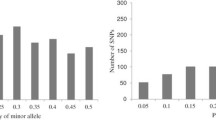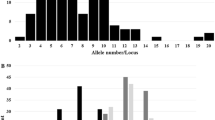Summary
Isozymes and restriction fragment length polymorphisms (RFLPs) have been proposed for use in varietal identification and selection for agronomic traits. Although the use of isozymes for these purposes has been well documented, evaluation of the efficacy of RFLP technology as applied to crop improvement is far from complete. This investigation was conducted to study the relationship between RFLP-derived genotypes and heterotic patterns of a group of maize (Zea mays L.) inbred lines. A total of 22 inbreds was crossed to four testers (B73, B76, Mo17, and Va26) in combinations that minimized crossing within heterotic groups. Forty-seven single-cross progeny were subsequently evaluated for several agronomic traits (including grain yield and moisture, ear height, and root lodging) over 2–4 consecutive years at two to four Iowa locations in a randomized complete-block design. The inbred lines were subjected to RFLP analysis, which involved 47 genomic clones and the restriction enzymes EcoRI and HindIII. Hybrid RFLP patterns were predicted from their inbred parents. Modified Roger's distances were computed to estimate genetic distance among the inbred lines. Principal component analysis facilitated ascertainment of relative dispersion of the inbreds based on the frequency of variants at specific RFLP loci. Evident associations of variants with genes affecting agronomic traits were identified by principal component regression analysis, in which adjusted hybrid means were regressed on the matrix of hybrid variants frequencies. The hybrid means were adjusted by removing environmental effects, using residuals as dependent variables in the regression analysis. Results from this study suggest that RFLP analysis may be of value in allocating maize inbreds to heterotic groups, but no relationship between RFLP-based genetic distance and hybrid performance was apparent. Principal component regression identified variants potentially linked to genes that control specific agronomic traits.
Similar content being viewed by others
References
Evola SV, Burr FA, Burr B (1986) The suitability of restriction fragment length polymorphisms as genetic markers in maize. Theor Appl Genet 71:765–771
Feinberg AP, Vogelstein B (1983) A technique for radiolabelling DNA restriction fragment length polymorphisms to hight specific activity. Anal Biochem 132:6–13
Frei OM, Stuber CW, Goodman MM (1986) Uses of allozymes as genetic markers for predicting performance in maize single-cross hybrids. Crop Sci 26:37–42
Gunst RF, Mason RL (1980) Regression analysis and its application. Marcel Dekker, New York
Hadjinov MI (1982) Interrelationships between isozymic diversity and combining ability in maize lines. Maydica 27:135–149
Helentjaris T, King G, Slocum M, Siedenstrang C, Wegman S (1985) Restriction fragment length polymorphisms as probes for plant diversity and their development as tools for applied plant breeding. Plant Mol Biol 5:109–118
Helentjaris T, Slocum M, Wright S, Schaefer A, Neinhuis J (1986) Construction of genetic linkage maps in maize and tomato using restriction fragment length polymorphisms. Theor Appl Genet 72:761–769
Henderson CB (1984) Maize research and breeders's manual, No. X. Illinois Foundation Seeds, Champaign, FL
Hocking RR (1976) The analysis and selection of variables in linear regression. Biometrics 32:1–49
Lamkey KR, Hallauer AR, Kahler AL (1987) Allelic differences at enzyme loci and hybrid performance in maize. J Hered 78:231–234
Lee M, Godshalk EB, Lamkey KR, Woodman WW (1989) Association of restriction fragment length polymorphism with agronomic performance of maize inbreds and hybrids. Crop Sci 29:1067–1071
Price SC, Kahler AL, Hallauer AR, Charmley P, Giegel P (1986) Relationships between performance and multilocus heterozygosity at enzyme loci in single-cross hybrids of maize. J Hered 77:341–344
Rogers JS (1972) IV. Measures of genetic similarity and genetic distance. Studies in Genetics VII. Univ Tex Publ 7213:145–153
Saghai-Maroof MA, Soliman KM, Jorgenson R, Allard RA (1984) Ribosomal DNA spacer length polymorphisms in barley: Mendelian inheritance, chromosomal location, and population dynamics. Proc Natl Acad Sci USA 81:8014–8018
SAS Institute (1985) SAS user's guide: statistics. SAS Institute, Cary/NC
Southern E (1975) Detection of specific sequences among DNA fragments separated by gel electrophoresis. J Mol Biol 98:503–517
Stuber CW, Moll RH, Goodman MM, Schaeffer HE, Weir BS (1980) Allozyme frequency changes associated with selection for increased grain yield in maize (Zea mays L.). Genetics 95:225–236
Author information
Authors and Affiliations
Additional information
Communicated by A. L. Kahler
Joint contribution: USDA-ARS and Journal Paper No. J-13590 of the Iowa Agriculture and Home Economics Experiment Station, Ames, IA 50011, USA. Projects No. 2818 and 2778
Rights and permissions
About this article
Cite this article
Godshalk, E.B., Lee, M. & Lamkey, K.R. Relationship of restriction fragment length polymorphisms to single-cross hybrid performance of maize. Theoret. Appl. Genetics 80, 273–280 (1990). https://doi.org/10.1007/BF00224398
Received:
Accepted:
Issue Date:
DOI: https://doi.org/10.1007/BF00224398




